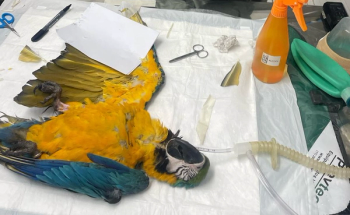
- dvm360 January 2023
- Volume 54
- Issue 1
- Pages: 30
Pet birds need fewer seeds, more formulated diets
Educate bird owners about common nutrition misconceptions to prevent disease
Despite improvements in feeding practices by bird owners over the past 2 decades, many pet birds have nutrition-related diseases. The exact nutrient requirements for pet birds are not known, and their dietary recommendations generally have been extrapolated from studies done with chickens and ducks.1,2 To better educate bird owners, veterinary professionals must be familiar with which nutrients are essential to pet bird health, how their nutritional needs differ from those of their wild counterparts, and what happens when those nutritional needs are not met.
Essential nutrients
Dietary components that provide energy and precursors for the synthesis of the body’s structural and functional macromolecules include macronutrients (eg, lipids, proteins, carbohydrates, water); micronutrients (eg, minerals); and fat-soluble vitamins (eg, vitamins A, D, E, K).3 Essential nutrients are required for optimal health and metabolism, and they are not synthesized adequately by the body. Although few studies have established the exact nutrient requirements of psittacine (parrot) and passerine (songbird) species, and many nutritional recommendations for pet birds have been based on chicken studies, some nutritional information has been gleaned from studies of budgerigars and cockatiels.4 These studies do not account for factors such as species differences in nutrient requirements and efficiency of nutrient absorption, plus variable requirements for different life stages and activities (eg, breeding/reproduction, growth, molting, exercise/flight, and aging).
Among the nutrients known to be essential for pet birds are vitamin A (for proper development of feathers and the epithelial linings of the respiratory and gastrointestinal tracts); vitamin D (for proper calcium and phosphorus metabolism, eggshell formation, and bone mineralization); vitamin E (for stabilization of lipids in cell plasma membranes and for proper immune system function); and vitamin K (for blood clotting). Other key nutrients for pet birds include omega-6 and omega-3 polyunsaturated fatty acids (for proper immune, cardiovascular, renal, and nervous system function, and for prevention of tissue inflammation/arthritis), calcium (for bone mineralization, eggshell calcification, nerve conduction, and muscle contraction), and essential amino acids (for building proteins that comprise organs, skin, and feathers—the largest protein-containing portion of a bird’s body).5
Common misconceptions
Unfortunately, most pet birds are not fed nutritionally complete and balanced diets. Pet bird owners equate their birds with wild birds that eat seeds, but wild birds need calories to fly and to forage for food, mates, and nest sites, whereas their pet counterparts do not. Wild birds graze all day without becoming obese because they constantly burn calories, but most pet birds rarely leave their cages, and consequently often become overweight. Unlike wild birds, pet birds are provided with food, so they don’t have to hunt, and pet birds bond to owners as “mates” so they don’t need to find other birds to bond with. Whereas food availability changes seasonally in the wild, allowing for nutritional variety and balance, pet birds typically are fed the same foods every day, often in excess.
Bird owners often provide their pets a base diet of seed with a smaller amount of fresh produce and a variety of other table foods, hoping their pets will get a nutritional balance from diverse options. However, usually pet birds become selective eaters, choosing only high-fat, tastier options, such as seed, and ignoring more nutritious choices, resulting in obesity and nutrient deficiency. Although vegetables and fruits may provide birds with some micronutrients, produce as the base diet does not meet the needs of pet birds. In addition, domestically grown produce has higher energy and water content with lower essential nutrient levels than wild-grown produce. Feeding pet birds excessive produce may cause dietary nutrient dilution.
The problem with seed-based diets is that they are high in fat. They also lack fat-soluble vitamins and critical minerals (eg, calcium, phosphorus, sodium, zinc, iron, iodine, selenium, manganese) and are deficient in key amino acids (eg, lysine, methionine, riboflavin, pantothenic acid, niacin, choline). Additionally, seed-based diets provide inadequate hydration and are overall nutritionally imbalanced. Chronic seed overconsumption leads to many serious health problems including hypovitaminosis A (causing poor skin/feather quality, kidney failure/gout, and respiratory issues), hypocalcemia and hypovitaminosis D (associated with egg binding and production of soft-shelled or shellless eggs), hypercholesterolemia, hypertriglyceridemia, obesity, arthritis, and fatty liver/liver failure. Atherosclerosis—the accumulation of lipids, calcium, and cellular debris into large, fibrous plaques that obstruct blood flow within arteries—is particularly common in older, seed-eating Amazon, African gray, and Quaker parrots, just as it is in humans who eat long-term high-fat diets. And atherosclerosis in birds also increases the risk for stroke and heart disease.
Promote the proper base diet
To combat this persistent trend of feeding a pet bird seeds, for the past 20 years many avian veterinarians have recommended feeding nutritionally complete formulated diets as the base diet. These diets are considered nutritionally balanced according to feeding recommendations extrapolated from pet poultry that were created years ago by a panel of expert avian veterinarians. Formulated products provide birds with all the essential nutrients, including vitamins and minerals and without excessive fat, to promote overall health. When fed along with smaller amounts of fresh produce, formulated products offer birds a manageable volume of food to consume daily that contains complete and balanced nutrition. Many formulated products also provide variety by coming in different shapes, sizes, and colors that contain the same nutrients. By offering variety in this way, these formulated diets eliminate the risk of birds becoming selective eaters.
Despite the nutritional benefits of formulated products, many bird owners resist these diets for several reasons. First, birds often initially don’t recognize formulated products as food, so converting them to formulated diets can take time. Many bird owners become frustrated and give up prematurely. Second, some bird owners think of formulated diets as boring, lacking variety, and limiting chances for foraging. Bird owners add produce and other table foods to formulated diets to try to increase variety and foraging opportunities, but this enables their pets to select only familiar foods, ignoring formulated products.
Fresh produce can be offered to pet birds to accompany a base diet of formulated products. When fed along with a predominantly pelleted diet, fresh produce provides micronutrients, variety, and enrichment through foraging; the high-water content of fruits and vegetables causing nutrient dilution is minimized when produce is fed as a complement to a formulated diet. Nutrient dilution is more common if formulated products make up less than 50% of the total diet. Table foods, including produce, ideally should comprise no more than 25% to 30% of the total diet so as not to upset overall nutritional balance when nutritionally complete formulated products are fed as the base diet.
Educate and support clients
To combat the entrenched misconception that pet birds should be fed either seed-or produce-based diets, veterinary professionals should stress to bird owners the nutritional importance of formulated diets and the detriment of seeds. They can explain that adding powdered or liquid vitamins to seeds is an ineffective way to balance a bird’s diet, as most species of pet birds (other than pigeons and doves that consume seeds whole) remove seed hulls before ingesting seed kernels and don’t benefit from vitamins coating the hulls. Bird owners also mistakenly try to balance their pet’s diet by adding supplemental vitamins to drinking water; doing this may deter a bird from drinking and lead to dehydration.
Veterinary staff treating birds should not only encourage bird owners to convert pets to formulated diets, but also provide them with ongoing support during the conversion process to ensure success. Different methods of transitioning birds from seeds to pellets have been developed, but not all methods work for all types of birds.6 Veterinarians treating birds regularly should be familiar with these different methods, many of which are described in peer-reviewed veterinary journals, so that they can guide bird owners through diet conversion. Many bird owners look to pet store employees and formulated pellet manufacturers to provide information on how to transition their pets from high-fat, nutritionally deficient seed diets to nutritionally balanced and complete formulated products. With support from the veterinary profession and the pet food industry, pet bird owners can become more educated about their pets’ nutritional needs and work toward helping birds live healthier, longer lives.
Laurie Hess, DVM, DABVP (Avian Practice), is 1 of approximately 100 board-certified avian specialists worldwide. After graduating from Yale University, she earned her veterinary degree at Tufts University and completed a 1-year internship and 2-year residency in avian/exotic pet medicine at the Animal Medical Center (AMC) in New York, New York. She was cohead of the Avian & Exotic Pet Service at the AMC, and opened the Veterinary Center for Birds & Exotics in Westchester County, New York. She also serves as the lead specialty (exotic) pet veterinarian for pet product retailer Chewy. Hess is the author of Unlikely Companions: The Adventures of an Exotic Animal Doctor–a memoir about life as an exotic animal veterinarian, and an active member of several veterinary professional organizations.
References
- National Research Council. Nutrient Requirements of Poultry. 8th ed. National Academy Press; 1984.
- Hawley B, Ritzman T, Edling TM. Avian nutrition. In: Olsen GH, Orosz SE, ed. Manual of Avian Medicine. Mosby; 2000; 369-90.
- Orosz SE. Clinical avian nutrition. Vet Clin North Am Exot Anim Pract. 2014;17(3):397-413. doi:10.1016/j.cvex.2014.05.003
- Earle KE, Clarke NR. The nutrition of the budgerigar (Melopsittacus undulatus). J Nutr. 1991;121(suppl 11):S186-S192. doi:10.1093/jn/121. suppl_11.S186
- Koutsos E, Gelis S, Echols SE. Advancements in nutrition and nutritional therapy. In: Speer BL, ed. Current Therapy in Avian Clinical Medicine and Surgery. Elsevier; 2016; 142-176.
- Cummings A, Hess LR, Spielvogel CF, Kottwitz JJ. An evaluation of three diet conversion methods in psittacine birds converting from seed- based diets to pelleted diets. J Avian Med Surg. 2022;36(2):145-152. doi:10.1647/21-00025
Articles in this issue
over 2 years ago
Rabbit endotracheal intubation: Yes, you can do it! (Part 2)over 2 years ago
Retirement planning and the potential 401(k) fallacyover 2 years ago
Veterinary-owned management companies: Why not?almost 3 years ago
ABCs of dentistry: Airway, breathing, and circulationalmost 3 years ago
The job descriptionalmost 3 years ago
Build your first veterinary hospitalalmost 3 years ago
The pet obesity epidemic: are we loving our pets to death?almost 3 years ago
Hypoadrenocorticism in the emergency settingalmost 3 years ago
Increasing efficiency and productivity in uncertain timesNewsletter
From exam room tips to practice management insights, get trusted veterinary news delivered straight to your inbox—subscribe to dvm360.






